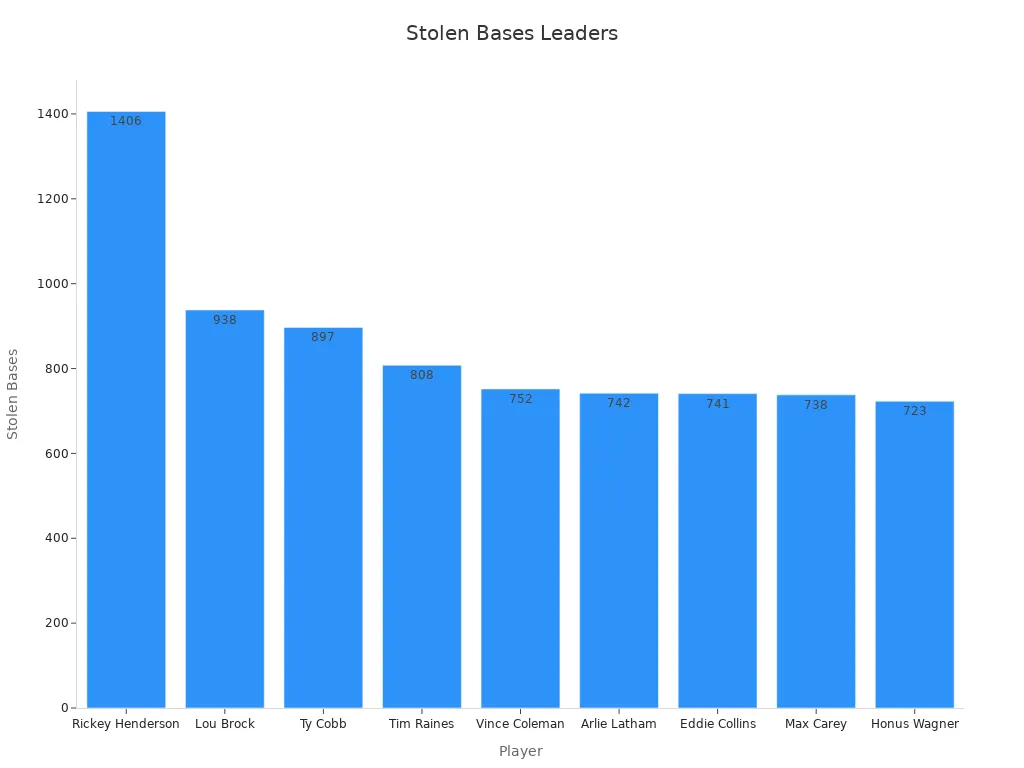
In baseball, “SB mean” stolen bases. A stolen base happens when a runner advances to the next base while the pitcher delivers the ball. Stealing bases highlights both speed and strategic decision-making. To benefit their team, players need to succeed at least 67% of the time. Ty Cobb, a legendary player, achieved an incredible 83% success rate, stealing 892 bases. In modern baseball, teams steal fewer bases, averaging around 60 per season in the 2020s, making stolen bases even more exciting to witness today.
Key Takeaways
Stolen bases (SB) are important in baseball. They show a player’s speed and smart decisions. SBs can help a team score more runs.
To steal a base, players need to plan well. Timing and knowing the pitcher’s moves are key. A good start and fast reaction decide success or failure.
Famous players like Rickey Henderson and Ty Cobb prove how important stolen bases are. Their records show how this skill can change a game.
What does sb mean and why is it important?
Definition of a stolen base
In baseball, a stolen base happens when a runner moves to the next base while the pitcher throws the ball. This move needs speed, good timing, and knowing the game situation. For it to count as a stolen base, the runner must reach the next base without the defense making an out or an error. For example, if a runner on first base runs to second base during the pitch and gets there before the throw, it’s a stolen base. But if the catcher throws them out, it’s called “caught stealing.”
Stolen bases are one of the most exciting parts of baseball. They show off a player’s speed and quick thinking. Watching a player steal a base is always a thrilling moment in the game.
Why stolen bases matter in baseball strategy
Stolen bases are very important for baseball strategy. They can change the flow of the game and help teams score. Teams use stolen bases to put pressure on the defense, forcing them to act quickly. A fast runner on base can also distract the pitcher, making it harder to focus on the batter.
Experts say stolen bases can help teams win more games. For example:
Cade Stanley says stolen bases are key in close games. A successful steal can boost your team’s chance of winning.
Theodore Turocy explains that a fast runner can help the batter. Defenders may move to prepare for a steal, leaving gaps in the field.
Herman Demmink III found that teams good at stealing bases win more games. On average, they win three more games than teams that don’t steal well.
These examples show that stolen bases are more than just personal achievements. They are a smart way to help the team win.
How stolen bases influence scoring opportunities
Stolen bases help teams score more runs. By moving to the next base, a runner gets closer to scoring. This increases the team’s chance of earning points. For instance, with a runner on first base and no outs, the chance of scoring is 44.1%. If the runner steals second base, the chance goes up to 63.7%. That’s a 19.6% increase. But if the runner gets caught stealing, the chance drops by 26.9%, showing the risk involved.
Situation | Run Expectancy (%) | Change (%) |
|---|---|---|
Runner on first base, no outs | 44.1 | |
Runner on second base, no outs | 63.7 | +19.6 |
Caught stealing | -26.9 |
In one game, a runner on first base with no outs had a run expectancy of 0.8588 runs. If caught stealing, it dropped to 0.2557 runs, losing 0.6031 runs. But a successful steal raised it to 1.0929 runs. This shows how stolen bases can change the game.
When watching a game, notice stolen bases. They’re not just about speed. They involve timing, strategy, and smart risks. A good steal can excite the team and bring them closer to winning.
How are stolen bases tracked and achieved?

Recording stolen bases in player statistics
Stolen bases are a key part of baseball stats. They show how fast and smart a player is. When a player steals a base, it’s marked as “SB” in their stats. If they get caught, it’s marked as “CS” (Caught Stealing). These numbers help calculate their success rate, which is the percentage of successful steals.
For example, if a player tries 50 steals and succeeds 40 times, their success rate is 80%. This shows how good they are at stealing bases. Coaches use these stats to judge players and plan strategies. A high success rate means the player knows when to take risks.
Strategies for stealing bases
Stealing a base takes more than just running fast. It needs planning, timing, and skill. Runners watch the pitcher’s habits, like how fast they throw. They also take a lead, which is the space between them and the base. A bigger lead helps them reach the next base faster.
Studies show that lead distance matters. Successful steals have an average lead of 22.90 feet. Unsuccessful ones have a lead of 20.53 feet. Bigger leads improve your chances. Coaches train players to take bigger leads but stay alert to avoid getting picked off.
Metric | Successful Stolen Bases | Unsuccessful Stolen Bases | Overall Mean |
|---|---|---|---|
Mean Secondary Lead Distance | 22.90 ft | 20.53 ft | 22.37 ft |
Feature Importance Score | 30.69% | N/A | N/A |
Another important strategy is timing your jump. Start running as soon as the pitcher throws the ball. This quick move can decide if you succeed or fail. Tools like Random Forest Classifier help players improve by studying timing and lead distance.
Factors affecting successful stolen bases
Many things affect a stolen base attempt. First, the runner must make quick and smart moves. Second, the pitcher’s speed can help or hurt the runner. A slow pitcher gives the runner more time. Third, the catcher’s throw matters. A fast, accurate throw can stop even the best runners. Lastly, timing is key. The runner must match their actions with the pitcher’s moves.
Factor | Description |
|---|---|
Runner | The runner’s choices and timing are very important. |
Pitcher | The pitcher’s speed affects the runner’s lead and jump. |
Catcher | The catcher’s throw speed and aim can stop the runner. |
Timing | The runner must act at the right moment to succeed. |
Knowing these factors can help you steal bases better. Focus on your lead, study the pitcher, and practice timing. Stealing bases isn’t just about speed. It’s about skill, strategy, and being aware of the game.
The historical importance of stolen bases
Famous players known for stealing bases
In baseball history, many players became famous for stealing bases. These players showed amazing speed, smart thinking, and perfect timing. Rickey Henderson, called the “King of Steals,” holds the record with 1,406 stolen bases. Lou Brock, another great player, stole 938 bases and held the record for years. Ty Cobb, known for his bold style, stole 897 bases, making him a feared runner.
Here’s a table showing some legendary players and their stats:
Player | Stolen Bases | Career Hits | Career Runs | Batting Average |
|---|---|---|---|---|
Rickey Henderson | 1,406 | N/A | N/A | N/A |
Lou Brock | 938 | N/A | N/A | N/A |
897 | N/A | N/A | N/A | |
Honus Wagner | 723 | 3,420 | 1,739 | .328 |
Vince Coleman | 752 | N/A | N/A | N/A |
These players not only stood out but also changed how teams used baserunning strategies.
How stolen bases changed over time
Stolen bases have changed a lot in baseball history. In the late 1800s, players like Billy Hamilton and Hugh Nicol showed how important speed was. By the 1970s, stolen bases became popular again as teams focused on speed instead of power. Players like Joe Morgan and Davey Lopes helped their teams by stealing bases. Teams even created new methods to help slower players steal bases.
During this time, success rates improved. By 1976, American League players succeeded 68.2% of the time when stealing bases. This showed how timing and precision became more important. Stolen bases became a key part of scoring and challenging defenses.
Stolen base records and achievements
Stolen base records show how important this skill is in baseball. Rickey Henderson is the only player with over 1,000 stolen bases, proving he’s the best. Lou Brock held the record from 1977 to 1991, and Billy Hamilton’s record lasted 81 years before Brock broke it. The 1911 New York Giants hold the team record with 347 stolen bases in one season, which hasn’t been beaten.
Here’s a chart comparing top stolen base records among players:

These records show how stolen bases have shaped baseball. They highlight both individual talent and team strategies. Stolen bases remain an exciting and smart part of the game, showing players’ skills and intelligence.
Stolen bases (“SB”) show a player’s speed and smart decisions. They are still exciting, even as teams change their plans.
Teams focus on players who succeed more at stealing bases.
Data now helps teams value stolen bases by success, not number.
Learning about stolen bases helps you enjoy baseball’s strategy and fun.
FAQ
What does sb mean in baseball stats?
SB in baseball stats stands for stolen bases. It tracks how many times a player successfully advances to the next base during a pitch.
How do stolen bases impact a game?
Stolen bases increase scoring chances by moving runners closer to home plate. They also disrupt the defense and create opportunities for the batting team.
Who holds the record for most stolen bases?
Rickey Henderson holds the record with 1,406 stolen bases. His speed and strategy made him the greatest base stealer in baseball history.
